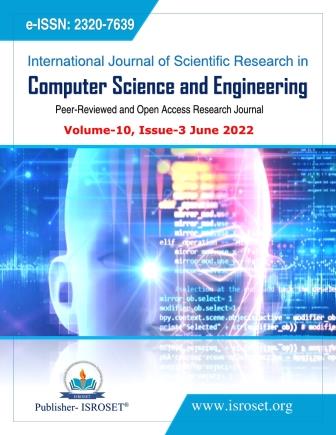Diagnosis of Chronic Kidney Disease Using Optimised Feature Selection and Ensemble Technique
Keywords:
Chronic Kidney Disease, Diagnosis, Diagnostic ModelAbstract
Chronic Kidney Disease (CKD) has been identified as an international challenge in healthcare that is increasing progressively. A survey showed that on average more than two million individuals over the world receive dialysis or transplanting kidney treatment to be alive. Prompt diagnosis of CKD is crucial. Prompt and applicable diagnosis demands the use of techniques in data mining. Recently, techniques now extend to a broad area in the diagnosis of a chronic kidney with importance mainly on accuracy via the simplification of disease by employing a selection of features together with pre-processing methods. This paper presented an optimised feature selection approach using the boosting of ensemble technique for CKD diagnostic model by the introduction of a nature-inspired computation algorithm known as Ant Colony Optimization for the selection of attributes from the CKD dataset. Seven selected learning algorithms were used for classification. The CKD diagnostic model was evaluated using an indigenous dataset collected from Ladoke Akintola University of Technology (LAUTECH) teaching hospital, Ogbomoso and Osogbo, University College HospitPredical (UCH), Ibadan, Oyo State and Obafemi Awolowo University Teaching Hospital. Results showed that the optimised CKD diagnostic model produced the best accuracy of 96.54% in Stage 5 of CKD using logistic regression classifier, the best sensitivity of 0.9650 was obtained in Stage 5 of CKD using logistic regression classifier and the best precision of 0.9700 was obtained in Stage 5 of CKD using logistic regression classifier
References
Arasu, S.D., & Thirumalaiselvi, R. "Review of Chronic Kidney Disease based on Data Mining Techniques" International Journal of Applied Engineering Research, Vol. 12, No. 23, pp. 13498–13505, 2017.
Arumugam, V., & Priya, S. B. "Selecting Dominant Features for the Prediction of Early-Stage Chronic Kidney Disease". Intelligent Automation and Soft Computing, Vol. 31, No. 2, pp. 947–959, 2022.
Basar, M. D., & Akan, A. "Detection of chronic kidney disease by using ensemble classifiers". 2017 10th International Conference on Electrical and Electronics Engineering, ELECO 2017, pp. 544–547, 2018.
Chauchan, A. "Enhancing Academic Decision making at Higher Educational Institutions using Classification and Clustering Techniques" International Journal of Scientific Research in Computer Science and Engineering, Vol. 8 No. 2, pp. 39–44, 2020.
Deepashri, K. S., & Kamath, A. "Survey on Techniques of Data Mining and its Applications". International Journal of Emerging Research in Management & Technology, Vol. 9359 No. 2, pp. 198–201, 2017.
Gopika, S. & Vanitha, M. `"Survey on Prediction of Kidney Disease by using Data Mining Techniques" International Journal of Advanced Research in Computer and Communication Engineering, Vol. 6, No. 1, pp. 198–201. 2019.
Hussain, K., Mohd Salleh, M. N., Cheng, S., & Shi, Y. "Metaheuristic research: a comprehensive survey" Artificial Intelligence Review, Vol. 52, No. 4, pp. 2191–2233, 2019.
Imani, M. B., Pourhabibi, T., Keyvanpour, M. R., & Azmi, R. "A New Feature Selection Method Based on Ant Colony and Genetic Algorithm on Persian Font Recognition". International Journal of Machine Learning and Computing, Vol. 2, No. 3, pp. 278–282, 2012.
O. A., Adetunmbi, A. O., Ogunrinde, R. B., & Badeji-Ajisafe, B. "Development of an Ensemble Approach to Chronic Kidney Disease Diagnosis" Scientific African, Vol. 8, pp. 1–15, 2020.
Komal, N, K., Tulasi, R. L., & Vigneswari, D. "An Ensemble Multi-Model Technique for Predicting Chronic Kidney Disease". International Journal of Electrical and Computer Engineering (IJECE), Vol. 9, No. 2, pp13-21. 2019.
Krishnaveni, N., & Radha, V. "Feature Selection Algorithms for Data Mining Classification: A Survey". Indian Journal of Science and Technology, Vol. 12, No. 6, pp.1–11, 2019.
Kumar, V. & Minz, S. "Feature Selection: A literature Review." The Smart Computing Review, Vol. 4, No. 3, pp. 211–229, 2014.
Luyckx, V. A., Tonelli, M., & Stanifer, J. W. "The global burden of kidney disease and the sustainable development goals". Bulletin of the World Health Organization, Vol. 96, No. 6, pp. 414–422, 2018.
Oladeji, F A, Idowu, P A, Egejuru, N. (2019). "Model for Predicting the Risk of Kidney Stone using Data Mining Techniques". International Journal of Computer Application, Vol. 182, No. 38, pp.36–56, 2019.
Patel, A., Shreya, P., & Amin. "A Survey on Heuristic Based Approach for Privacy-Preserving in Data Mining". International Journal of Scientific Research in Computer Science and Engineering, Vol. 5, No. 5, pp. 21–25, 2017.
Ram, Shrawan and Doegar, A. "A Comparative Study of Data Mining Techniques for Predicting Disease Using Statlog Heart Disease Database". International Journal of Advanced Research in Computer Science and Software Engineering, Vol., No. 6, 1202–1210, 2015
Shardlow, M. "An Analysis of Feature Selection Techniques". The University of Manchester, Vol. 14, No.1, pp.1–7, 2016.
Tabassum, S., Mamatha B.& Majumdar, J. "Analysis and Prediction of Chronic Kidney Disease using Data Mining Techniques". International Journal of Engineering Research in Computer Science and Engineering, Vol. 4, No. 9, pp.25–32, 2017
Teng, X., & Gong, Y. "Research on Application of Machine Learning in Data Mining". IOP Conference Series: Materials Science and Engineering, Vol. 392, No. 6. 2018.
Tripathi, A., Nadaf, A., & Yadav, A. K. (2020). "Identification of the Stages of Chronic Kidney Disease Using Data Mining Approach". International Research Journal of Modernization in Engineering Technology and Science, Vol. 2, No. 8, pp.463–467, 2020.
Wang, W., Chakraborty, G., & Chakraborty, B. "Predicting the Risk of Chronic Kidney Disease ( CKD ) Using Machine Learning Algorithm". Applied Sciences, Vol. 11, No.202, pp.1–17, 2021.
Downloads
Published
How to Cite
Issue
Section
License

This work is licensed under a Creative Commons Attribution 4.0 International License.
Authors contributing to this journal agree to publish their articles under the Creative Commons Attribution 4.0 International License, allowing third parties to share their work (copy, distribute, transmit) and to adapt it, under the condition that the authors are given credit and that in the event of reuse or distribution, the terms of this license are made clear.







